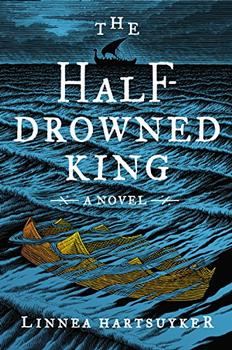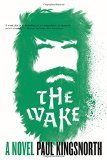Summary | Excerpt | Reading Guide | Reviews | Beyond the book | Read-Alikes | Genres & Themes | Author Bio

From the book jacket: Katla is a slave and daughter of a Christian woman
captured in a Viking raid on Irish shores. Setting sail from Iceland with her
master's household, she heads toward the distant promise of a new homestead in
Greenland. Also on the ship is Thorbjorg the Seeress, a much maligned and
persecuted healer and prophetess who is ever faithful to the call of her patron
god, Odin.
Upon first arriving in Greenland, Katla is brutally raped by her master's son,
Torvard. The child of this union is Bibrau: taciturn, reclusive, infused with
the savagery of her conception and suspected by many to be a changeling. But the
seeress Thorbjorg, following a vision from her god, takes Bibrau as her
apprentice. The young girl becomes an adept at healing and Norse magic, but her
bitterness perverts the wisdom Thorbjorg gives. As her power grows, Bibrau
twists it to good or evil at her whim, inflicting her will on Thorbjorg's
household, her mother and the tight-knit Greenland community.
Comment: The word epic is thrown around a little too freely in
literary circles, but if any recent book deserves the title it is The
Thrall's Tale which recounts the early years of the settlement of Greenland
by the Norse led by Eirik Raude (Erik The Red). Much of Lindbergh's
inspiration is from the contemporary chronicles known as Eirik's Saga and Graenlendinga Saga,
collectively known as the
Vinland Sagas, which record that in 985, Eirick Raude led 400 settlers and 25 ships
from Iceland to the shores of Greenland; and the Norse myths found in the
Younger Edda
(compiled in the 13th century) and the earlier
Poetic Edda.
The Thrall's Tale is told
through the eyes of three strong women, Katla, a thrall (slave) born of a
Christian-Irish mother captured and enslaved in a Viking raid shortly before
Katla's birth. Katla's beauty and her prayer beads set her apart
from the other thralls and draw the unwanted attentions of the master's son,
which leads to the maiming of Katla and birth of her unwanted daughter Bibrau,
the second voice of the tale. Lindbergh thinks of
Bibrau as a "silent scream." "She personifies all the terrible thoughts that one
can have in a moment of rage or at the realization of hatred ..... Her very
silence is at the core of her belligerence and power. By making her mute by
choice, Bibrau is free to say anything, do
anything, and no one would ever know her true intent except the reader."
The third voice is that of the seeress Thorbjorg (who, like a number of
Lindbergh's characters, is extrapolated from a passing mention in the Vinland
Sagas). Thorbjorg sees in Bibrau a surrogate daughter and apprentice,
someone to whom she can teach her mystical Norse wisdom, but even she fails to
see the devastating evil that lurks in Bibrau.
Her characters are realistically flawed and no-one, with the possible exception
of Katla's love interest, Ossur, is entirely likeable. However, with a
large cast, it can be difficult to keep track of who's who, not least because,
in keeping with the practice of the time, a great many of the names are prefixed
with Thor, denoting kinship to the thunder-god of the Norse.
Lindbergh has done her best to distinguish between them by using the prefix Thor
for some names and the more modern variation, Tor, for others, but it is still a
little muddling and a list of key people and their relationships would have
helped.
One of the most notable aspects of The Thrall's Tale is the language
used. It is as if Lindbergh has scraped away the Latin influences on the
English language leaving behind the archaic syntax and vocabulary of the older
Anglo-Saxon and Old Norse roots. The result is a moody, dark writing style,
positively reeking with atmosphere and foreboding that, once one is used to it,
evokes the bleak landscape and tough people to a tee. In the interview at
BookBrowse Lindbergh explains that the language used came to her after extensive
reading of the the old chronicles, but mostly from reading the eddas which are
considerably more musical and poetic than the somewhat matter of fact
chronicles. Lindbergh does not speak Old Norse or Icelandic (modern
Icelandic has changed relatively little since the 13th century) so relied on
translations, and was particularly drawn to a translation by Lee M Hollander
which was rich in the music, poetry and emotion that she longed for, which she
allowed to seep into her, so they could ooze out in her character's voices.
About the author
Lindbergh, who had formerly published poetry, travel and cultural pieces in
various journals, was inspired to write The Thrall's Tale after seeing
full-scale modern replicas of the ships that had sailed in Lief Eiriksson's wake
on the journeys he took from Norway to Iceland, Greenland and Canada and then
down the North American coast (see map in sidebar). She was
struck by the fact that the ships were barely bigger than oversized rowboats,
and completely open to the wind and sea and waves. This led her to start
researching the story of the early Greenland settlements, their early promise
and mysterious demise. She was most intrigued, not by the disappearance of
the settlements themselves, but by the powerful image of the pagan seeress, Thorbjorg,
who prophecies in Eirik’s Saga. Her exploration veered quickly into the
realm of archaeology as she slowly uncovered fragments of detail and placed them together in the growing mosaic of
her outline
She is currently working on a novel set in an entirely different time and
culture, "farther in the past
but again about women's lives" Being a little superstitious she doesn't
like to reveal more.
Did you know?
Sunday is derived from the Scandinavian/Germanic word Sonntag - sun
day. Monday comes from Monandaeg - moon day, from the same roots.
Tuesday is named for the Norse god Tyr or Tiw, the god of war. Wednesday (Wodnesdaeg)
is for Odin, also known as Woden, who sat at the top of the Norse pantheon.
Thursday is for the Norse god of thunder, Thor. Friday, frigedaeg,
is for the female goddess Frigga, Odin's wife and the goddess of marriage and
home. Only Saturday has its roots in the Roman pantheon - Saturn, the
Roman god of time and harvest - when the Ango-Saxons invaded England, the Roman
dies saturni became saterdaeg.
![]() This review
first ran in the February 21, 2007
issue of BookBrowse Recommends.
This review
first ran in the February 21, 2007
issue of BookBrowse Recommends.

If you liked The Thrall's Tale, try these:

by Linnea Hartsuyker
Published 2018
An exhilarating saga of the Vikings that conjures a brutal, superstitious, and thrilling ninth-century world and the birth of a kingdom - the debut installment in a historical literary trilogy that combines the bold imagination and sweeping narrative power of Game of Thrones, Vikings, and Outlander.

by Paul Kingsnorth
Published 2015
"A work that is as disturbing as it is empathetic, as beautiful as it is riveting." - Eimear McBride, New Statesman
Your guide toexceptional books
BookBrowse seeks out and recommends the best in contemporary fiction and nonfiction—books that not only engage and entertain but also deepen our understanding of ourselves and the world around us.